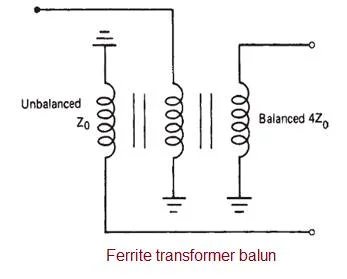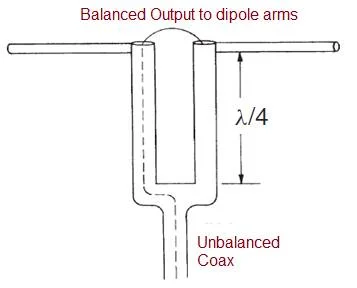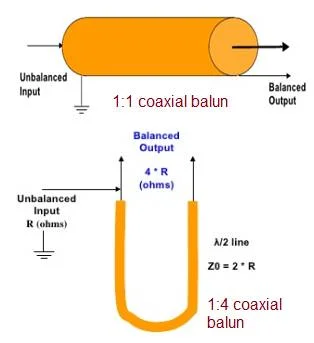Different types of Baluns | applications of Balun types
This article covers different types of Baluns and mentions applications of these Balun types. It describes different types of Baluns viz. L-C balun, transformer balun, Folded balun, coaxial balun, microstrip balun etc.
What is Balun?
Introduction:
• Balun is a device which connects balanced transmission line to unbalanced transmission line.
• Balun is the short form of Balanced-Unbalanced. It is the device which matches two
different impedances. For example, balun transformer connects transmission feed line with antenna.
In this application it converts impedance from 300 ohm to 75 ohm and vice versa. Here 300 Ohm is free space impedance and
75 ohm is coaxial line impedance.
In short, there are two major functions of a balun.
• Impedance transformation
• Balanced to unbalanced transmission
Balun Types | Types of baluns with their applications
Let us understand different types of baluns with their applications.
LC balun

The figure-1 depicts LC balun type. It consists of two inductors and two capacitors. It introduces +/-90 degree of phase shift. In this circuit operating frequency is kept below self resonance frequency.
Application: It is used at the output of push-pull amplifier to convert balanced signal to un-balanced signal output.
Transformer balun

The figure-2 depicts transformer balun type. This balun type does not have any transmission line equivalent circuit. Its balanced mode output impedance is 4 times that of input unbalanced mode.
Application: It is used in a television antenna for impedance matching.
Folded balun

The figure-3 depicts folded balun type. A dummy coaxial outer conductor is connected to the pole which is fed from the center conductor. It runs alongside the feeder coax for λ/4 and connects to ground. The other pole connects directly to the shield of the feeder coaxial. The outer conductor of the coaxial cable and the extra line are two lines in a three-wire line with ground.
Application: It allows direct connection of a coax line to the dipole antenna.
coaxial balun

It is designed using λ/4 length of transmission line or coax cable. There are two types of coaxial balun viz. 1:1 coaxial balun and 1:4 coaxial balun. The figure-4 depicts the same. The 1:1 impedance transformation is achieved using quarter length of coax cable. 1:4 impedance transformation is achieved using the other balun design as shown.
Application: It is used in transmission line or coax cable based systems to achieve 1:1 and 1:4 impedance transformations.
Microstrip balun

This balun types are realized on PCB or specially manufactured microstrip dielectric substrates. The figure-5 depicts simple coupled line microstrip balun type. The structure has λ/4 wavelegth at the center frequency. It is also known as parallel line balun.
Application: It is used for bandwidths over an octave provided coupling between the lines is very high. The microstrip balun types include rat race coupler, multiple coupled line, printed marchand balun, microstrip based LC balun etc.
Other Balun Types
Following are the other types of baluns.
• Sleeve balun or Bazooka balun
• Split coax balun
• Half wavelength balun
• Candelabra balun
• Ferrite core balun
• Ferrite Candelabra balun
• Split Tapered coax balun
• Natural balun
Refer generic advantages and disadvantages of balun >> for more information.
Sensor basics and Different types of Sensors
Proximity Sensor Occupancy Sensor vs Motion Sensor LVDT and RVDT sensor Position, displacement and level sensor force sensor and strain sensor temperature sensor pressure sensor Humidity sensor MEMS sensor Touch sensor Haptic sensor Wireless sensor
Advantages and Disadvantages of different types of sensors
RF and Wireless Terminologies
What is Difference between
difference between FDM and OFDM
Difference between SC-FDMA and OFDM
Difference between SISO and MIMO
Difference between TDD and FDD
FDMA vs TDMA vs CDMA
FDM vs TDM
